Types of Crane Birds
Tall magnificent birds with long legs and necks, cranes spend most of their lives near the shallow water of swamps, lakes, streams, and ponds to hunt for prey and construct their nests. There are 15 species of cranes still living worldwide, all of which belong to the family of Gruidae. Their diet normally consists of insects, fish, rodents, small reptiles and amphibians, vegetation, and even some cultivated plants. They will root around with their beaks in the shallow water or sand in search of small morsels to consume. Their diet is also accompanied by small pebbles and grits to help them grind up food in their stomach.
One of the most interesting facts about cranes is that they perform an elaborate courtship dance to attract a potential mate. Many of them pair up for multiple reproductive seasons and raise the young together. However, because their native wetlands are among the most threatened habitats in the world, cranes are also endangered with extinction. This article will cover some basic facts about the identification and behavior of eight different types of crane birds from all around the world. Many of the species on this list have unusual appearances or some other interesting facts about them.
#8: Brolga
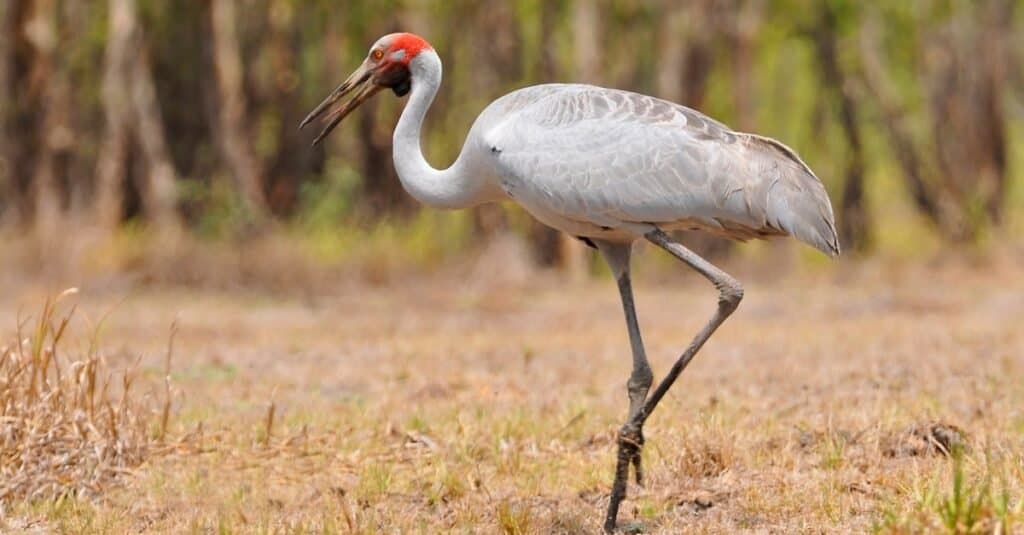
Cezary Wojtkowski/Shutterstock.com
The brolga, also known as the Australian crane, is characterized by a gray-colored body and redhead. Perhaps the most conspicuous mark of identification is the gular pouch located on the neck. Covered in dense black bristles, the pouch is particularly obvious on the male; it may help amplify his mating call during the reproductive season. The brolga is entirely native to Australia and the surrounding islands. When the rainy season arrives, these birds will engage in an elaborate courtship ritual that involves an intricate dance of bowing, strutting, and bobbing their heads either in pairs or entire groups. Although classified as a species of least concern by the IUCN Red List, numbers appear to be declining across its entire range.
#7: Demoiselle Crane
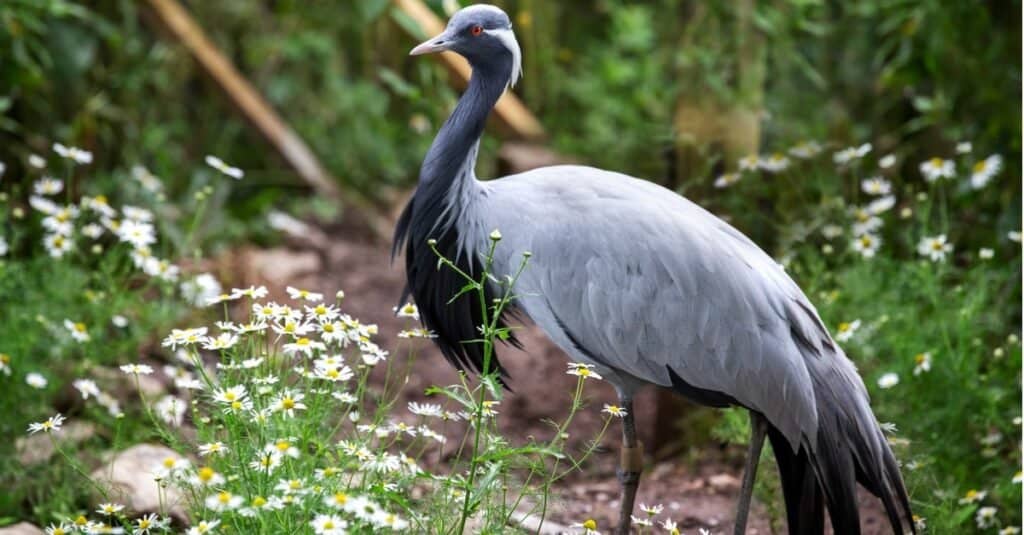
iStock.com/vyasphoto
The demoiselle crane is endemic to the wetlands, streams, and lakes of Eurasia, from the shores of the Black Sea to China. When the winter arrives, it travels south for the warmer climates of India and Africa. Some flocks make a very difficult journey right over the Himalayas, which exposes them to fatigue and hunger, and even death. This species is characterized by light gray plumage covering most of its body combined with black feathers around the neck and underside and white feathers extending from the red eyes to the back of the head. The IUCN Red List considers this to be a species of least concern with perhaps some 250,000 individuals remaining in the wild.
#6: Siberian Crane
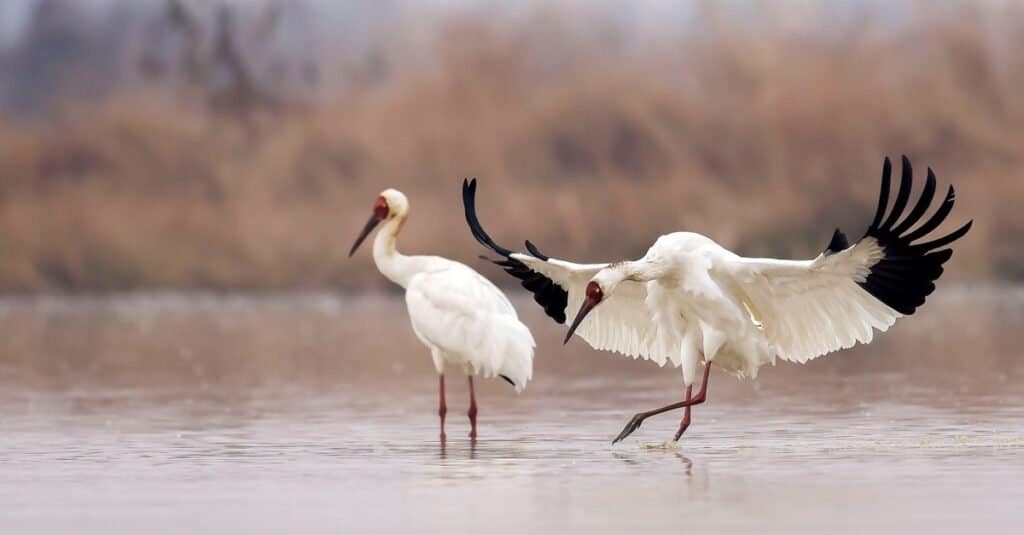
Wang LiQiang/Shutterstock.com
The Siberian crane is covered in a distinctive all-white plumage, only interrupted by the red feathers on the face and a few black marks around the wings that are visible in flight. Though well-suited for the inhospitable climates of northern Siberia, this white crane still migrates as far south as India and China for the winter. The IUCN Red List considers the Siberian white crane to be critically endangered in the wild with only a few thousand individuals remaining. Unfortunately, one of their last main refuges is under threat from the construction of the Three Gorges Dam in the Poyang Lake basin of China, which might drive them even further toward extinction.
#5: Black-Crowned Crane
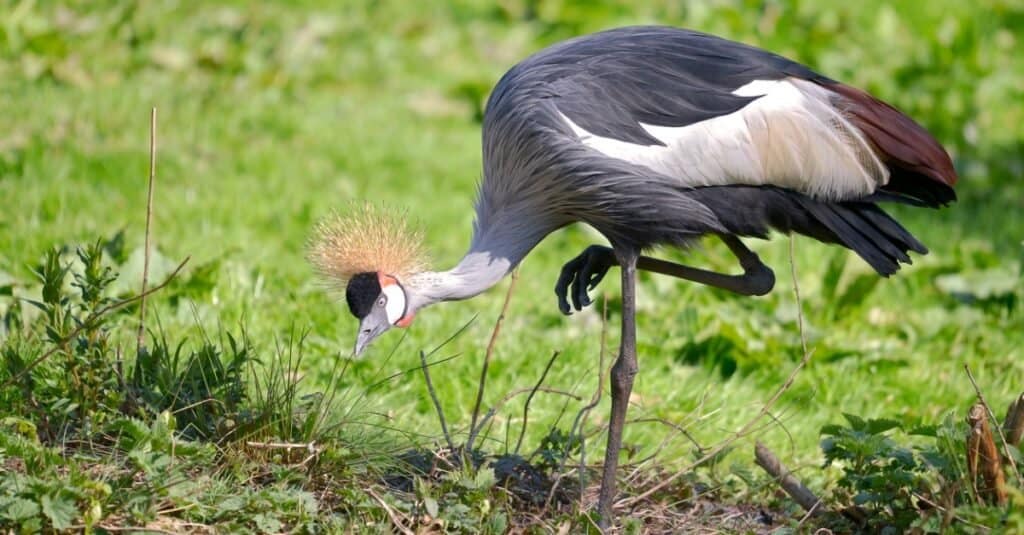
iStock.com/Musat
With its black plumage, large red cheek patches, and luxurious arc of golden feathers adorning its head, the aptly named black-crowned crane stalks the shallow wetlands of sub-Saharan Africa in search of its normal diet of insects and fish. The gold crown does not seem to serve a reproductive purpose, because the males and females have the same feature; the two sexes are generally indistinguishable from each other except for the male’s larger size, which is the main mark of identification. The IUCN Red List classifies them as a vulnerable species with an estimated 50,000 mature individuals left in the wild. A closely related species called the Grey-crowned crane is similar in shape and size, but it has a gray-colored body and lives more toward the southern and eastern parts of Africa.
#4: Sarus Crane
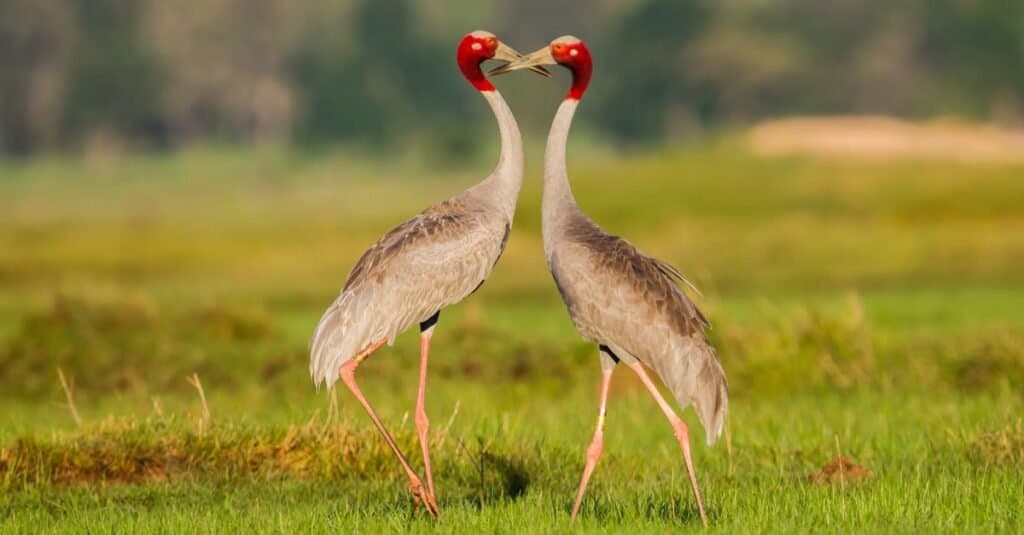
kajornyot wildlife photography/Shutterstock.com
A native of the wetland habitats of India, Southeast Asia, and Australia, the Sarus crane is considered to be the tallest flying bird in the world, because it stands at a height of around 6 feet. This species is also characterized by gray plumage with deep red feathers on the head and upper neck. When the mating season arrives, the male will perform a particularly intricate dance that consists of elegant leaps and movements. Once a mate is chosen, the parents will then construct a huge circular platform of reeds and grasses, more than 6 feet in diameter, in the water. As a symbol of marital fidelity, Sarus pairs are thought to mate for life and even mourn for the loss of a dead mate.
#3: Whooping Crane
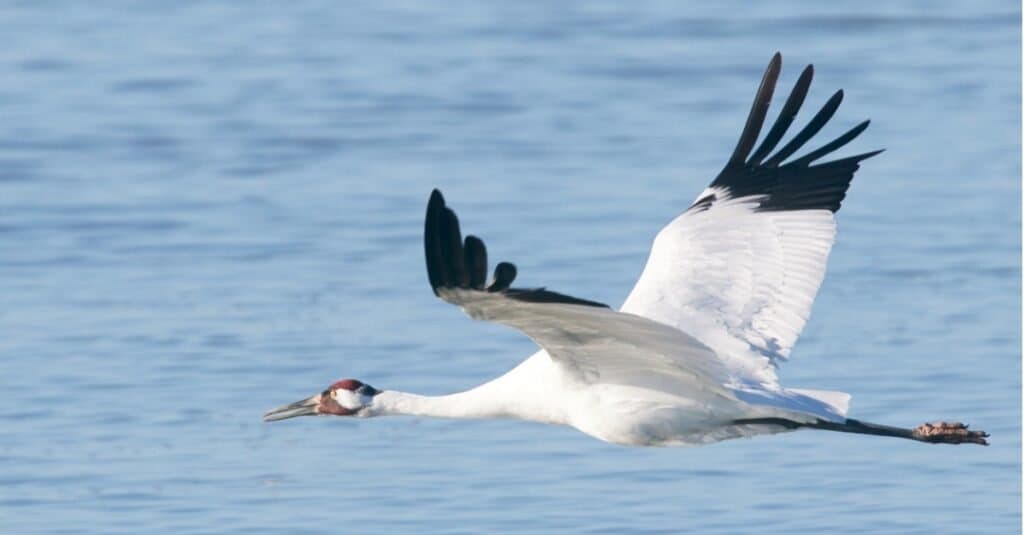
iStock.com/kellington1
Standing more than 5 feet tall (with a wingspan of nearly 8 feet long), the whooping crane is the tallest bird in North America by height alone. It is also characterized by the white body, the red crown, and the black wingtips, which should make identification easy. Whooping cranes are endemic to the northern part of the continent. Upon the first signs of winter, they migrate as far south as Florida and Louisiana. This species is also one of the most endangered crane species in the world. The combined effects of unregulated hunting and habitat loss nearly drove these white cranes to the brink of extinction by the middle of the 20th century. Several efforts have been made to reintroduce them into their former habitats, but according to the IUCN Red List, there are still not many more than 250 mature individuals remaining in the wild.
You can read a bit more about the whooping crane here.
#2: Sandhill Crane
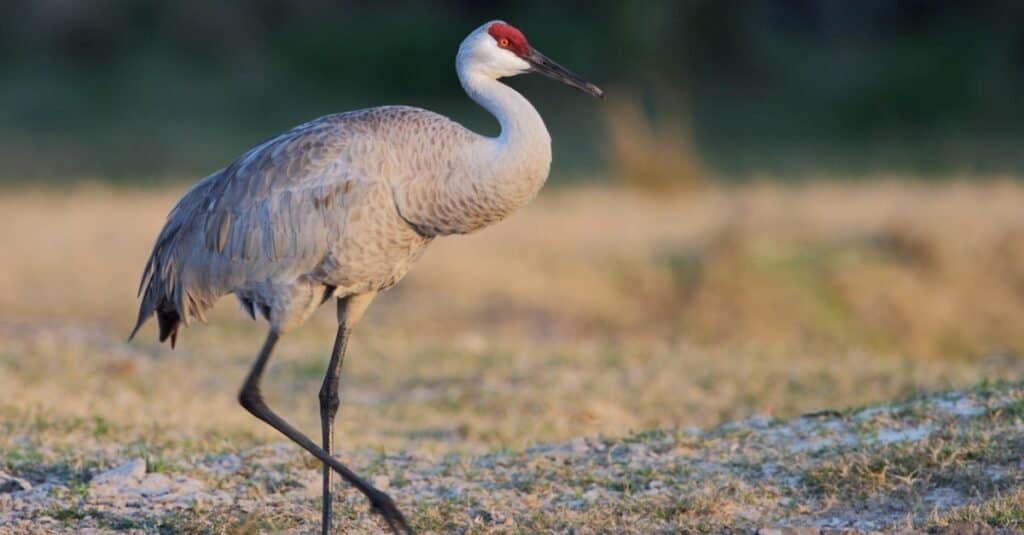
iStock.com/WMarissen
The sandhill crane is endemic to North America and northeastern Siberia. It can be identified by a gray-colored body (which turns brown and sand-colored in the reproductive system) with a red forehead, white cheeks, and a dark pointed bill. When the winter season approaches, this bird will travel south toward the United States and Mexico in flocks of hundreds. Upon arriving at these wintering grounds, they can easily form a flock of more than 10,000 at a time. The sandhill crane is one of the most common and populous cranes with approximately half a million mature individuals in the wild, according to the IUCN Red List.
#1: Common Crane

iStock.com/Piotr Krzeslak
The common crane, also known as the Eurasian crane, can be identified by the slate gray color of the body, the red crown, and the white stripe extending from the eyes and down the neck. It spends the breeding season in northern Eurasia and then travels south, sometimes even as far as sub-Saharan Africa, for the winter. Weighing about 10 pounds and standing about 4 feet in size, this is one of the smallest types of crane birds in the world, yet it’s also among the most populous as well. Thanks to its extensive range, there may be as many as 400,000 mature individuals still remaining in the wild. This bird has even begun to appear in Ireland again after a lengthy absence.
FAQs (Frequently Asked Questions)
How many types of cranes birds are there?
There are currently 15 crane species recognized around the world.
What kind of bird is a crane?
The crane is a water bird that belongs to the order of Gruiformes. The order includes all cranes, crakes, and rails.
Which is the largest crane species?
The Sarus crane is considered to be the tallest flying bird in the world (not counting the non-flying birds such as ostriches). It can reach a maximum height of nearly 6 feet. The brolga is the heaviest crane at 18 pounds.
What is the difference between a heron and a crane?
Herons, which belong to an entirely separate order of pelican-like birds, are not closely related to herons at all. The main difference comes down to their neck. Cranes tend to have shorter necks that they hold out straight in flight. Herons have longer curved S-shaped necks which they can pull back against the body. There are also several more differences related to reproduction and nesting behavior. Some species of herons will nest in trees or shrubs.
More from A-Z Animals
Tall magnificent birds with long legs and necks, cranes spend most of their lives near the shallow water of swamps, lakes, streams, and ponds to hunt for prey and construct their nests. There are 15 species of cranes still living worldwide, all of which belong to the family of Gruidae. Their diet normally consists of insects, fish, rodents, small reptiles and amphibians, vegetation, and even some cultivated plants. They will root around with their beaks in the shallow water or sand in search of small morsels to consume. Their diet is also accompanied by small pebbles and grits to help them grind up food in their stomach.
One of the most interesting facts about cranes is that they perform an elaborate courtship dance to attract a potential mate. Many of them pair up for multiple reproductive seasons and raise the young together. However, because their native wetlands are among the most threatened habitats in the world, cranes are also endangered with extinction. This article will cover some basic facts about the identification and behavior of eight different types of crane birds from all around the world. Many of the species on this list have unusual appearances or some other interesting facts about them.
#8: Brolga

Cezary Wojtkowski/Shutterstock.com
The brolga, also known as the Australian crane, is characterized by a gray-colored body and redhead. Perhaps the most conspicuous mark of identification is the gular pouch located on the neck. Covered in dense black bristles, the pouch is particularly obvious on the male; it may help amplify his mating call during the reproductive season. The brolga is entirely native to Australia and the surrounding islands. When the rainy season arrives, these birds will engage in an elaborate courtship ritual that involves an intricate dance of bowing, strutting, and bobbing their heads either in pairs or entire groups. Although classified as a species of least concern by the IUCN Red List, numbers appear to be declining across its entire range.
#7: Demoiselle Crane

iStock.com/vyasphoto
The demoiselle crane is endemic to the wetlands, streams, and lakes of Eurasia, from the shores of the Black Sea to China. When the winter arrives, it travels south for the warmer climates of India and Africa. Some flocks make a very difficult journey right over the Himalayas, which exposes them to fatigue and hunger, and even death. This species is characterized by light gray plumage covering most of its body combined with black feathers around the neck and underside and white feathers extending from the red eyes to the back of the head. The IUCN Red List considers this to be a species of least concern with perhaps some 250,000 individuals remaining in the wild.
#6: Siberian Crane

Wang LiQiang/Shutterstock.com
The Siberian crane is covered in a distinctive all-white plumage, only interrupted by the red feathers on the face and a few black marks around the wings that are visible in flight. Though well-suited for the inhospitable climates of northern Siberia, this white crane still migrates as far south as India and China for the winter. The IUCN Red List considers the Siberian white crane to be critically endangered in the wild with only a few thousand individuals remaining. Unfortunately, one of their last main refuges is under threat from the construction of the Three Gorges Dam in the Poyang Lake basin of China, which might drive them even further toward extinction.
#5: Black-Crowned Crane

iStock.com/Musat
With its black plumage, large red cheek patches, and luxurious arc of golden feathers adorning its head, the aptly named black-crowned crane stalks the shallow wetlands of sub-Saharan Africa in search of its normal diet of insects and fish. The gold crown does not seem to serve a reproductive purpose, because the males and females have the same feature; the two sexes are generally indistinguishable from each other except for the male’s larger size, which is the main mark of identification. The IUCN Red List classifies them as a vulnerable species with an estimated 50,000 mature individuals left in the wild. A closely related species called the Grey-crowned crane is similar in shape and size, but it has a gray-colored body and lives more toward the southern and eastern parts of Africa.
#4: Sarus Crane

kajornyot wildlife photography/Shutterstock.com
A native of the wetland habitats of India, Southeast Asia, and Australia, the Sarus crane is considered to be the tallest flying bird in the world, because it stands at a height of around 6 feet. This species is also characterized by gray plumage with deep red feathers on the head and upper neck. When the mating season arrives, the male will perform a particularly intricate dance that consists of elegant leaps and movements. Once a mate is chosen, the parents will then construct a huge circular platform of reeds and grasses, more than 6 feet in diameter, in the water. As a symbol of marital fidelity, Sarus pairs are thought to mate for life and even mourn for the loss of a dead mate.
#3: Whooping Crane

iStock.com/kellington1
Standing more than 5 feet tall (with a wingspan of nearly 8 feet long), the whooping crane is the tallest bird in North America by height alone. It is also characterized by the white body, the red crown, and the black wingtips, which should make identification easy. Whooping cranes are endemic to the northern part of the continent. Upon the first signs of winter, they migrate as far south as Florida and Louisiana. This species is also one of the most endangered crane species in the world. The combined effects of unregulated hunting and habitat loss nearly drove these white cranes to the brink of extinction by the middle of the 20th century. Several efforts have been made to reintroduce them into their former habitats, but according to the IUCN Red List, there are still not many more than 250 mature individuals remaining in the wild.
You can read a bit more about the whooping crane here.
#2: Sandhill Crane

iStock.com/WMarissen
The sandhill crane is endemic to North America and northeastern Siberia. It can be identified by a gray-colored body (which turns brown and sand-colored in the reproductive system) with a red forehead, white cheeks, and a dark pointed bill. When the winter season approaches, this bird will travel south toward the United States and Mexico in flocks of hundreds. Upon arriving at these wintering grounds, they can easily form a flock of more than 10,000 at a time. The sandhill crane is one of the most common and populous cranes with approximately half a million mature individuals in the wild, according to the IUCN Red List.
#1: Common Crane

iStock.com/Piotr Krzeslak
The common crane, also known as the Eurasian crane, can be identified by the slate gray color of the body, the red crown, and the white stripe extending from the eyes and down the neck. It spends the breeding season in northern Eurasia and then travels south, sometimes even as far as sub-Saharan Africa, for the winter. Weighing about 10 pounds and standing about 4 feet in size, this is one of the smallest types of crane birds in the world, yet it’s also among the most populous as well. Thanks to its extensive range, there may be as many as 400,000 mature individuals still remaining in the wild. This bird has even begun to appear in Ireland again after a lengthy absence.






